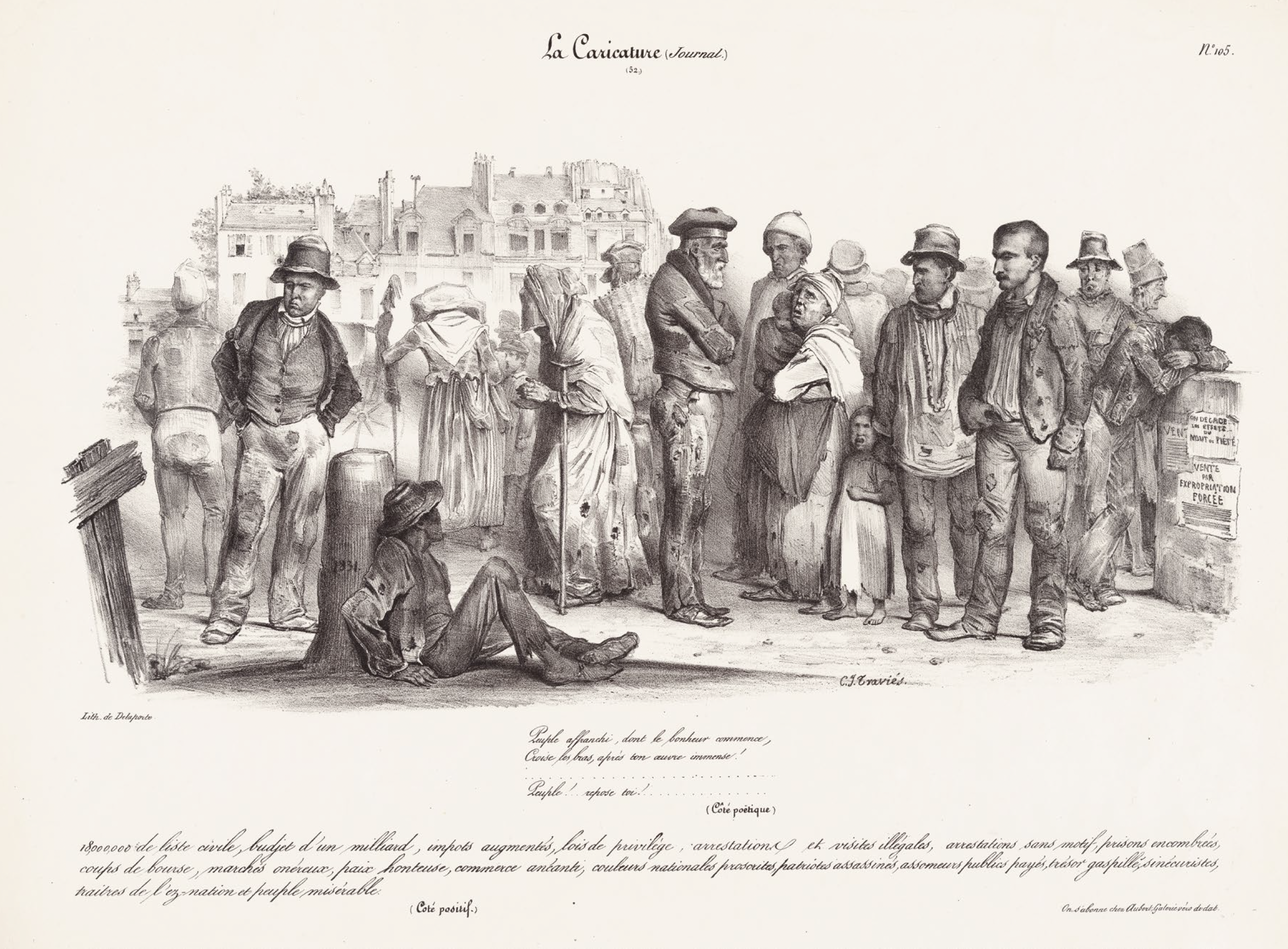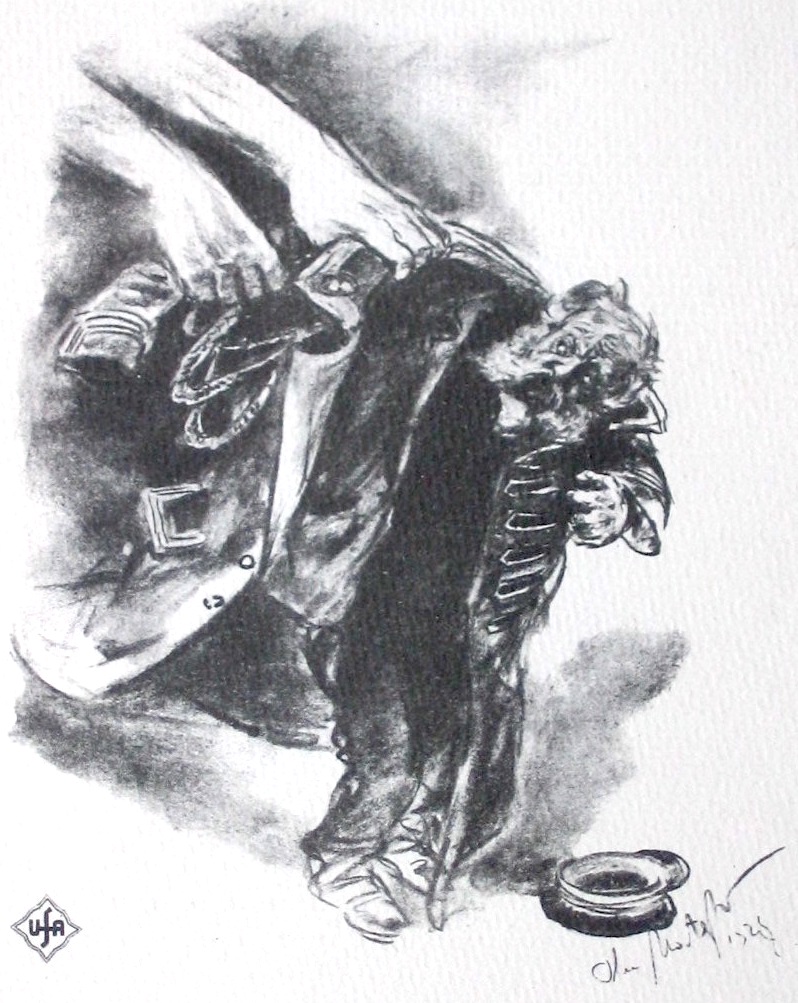Christoph Kappler]
[June 24, 2008
Isidore Pils: History Painter and “Realist Reporter”
11 January, 1871. Snow covers the bunker installations of Bastion 69, southwest of Paris. Several soldiers are on guard with shouldered rifles and fixed bayonets. An icy wind is blowing over the defence walls. One waits, time seems to stand still, as if it were frozen. One person among the guards is not a soldier, but long a member of the crew all the same. He is the painter and draughtsman Isidore Pils, a regular guest there to capture the situation of the siege of Paris by the Prussian troops in a series of watercolours. “At times, not even a hot brick under the water glass could prevent the water from freezing; occasionally it even froze on the brush and the ink clotted in iridescent patterns on the paper.” Despite these adversities, which Louis Becq de Fouquières describes in his biography “Isidore Pils. Sa vie et ses œuvres” from 1876, the painter is not dissuaded from creating a further watercolour that same day. A soldier stands opposite him, the sky has already taken on an evening hue.
Isidore Pils, skinned cat, near Auteuil, 1871, watercolour and gouache (Collection Steinhart-Leins). This watercolour sketch reveals Pils’ interest in scenic details. The skinned animal appears again in a picture exhibited a short time later depicting a soldier ready to prepare his meal.
M. BOCOURT, wood engraving after a painting of Isidore Pils in Le Monde Illustré, 1876 (detail), MePri Collection.
Isidore Pils (1813-1875), one of the most successful painters of the French Second Empire, was trained in the studio of the French history painter Francois Picot. In 1838 he won an academic competition and was granted a five-year residency at the Villa Medici in Rome, which during this period was headed by Ingres. Upon returning to Paris, he liberated himself in 1844 from the classical stance of his artist models and began developing his own style. According to Becq de Fouquières, the decisive turning point in his artistic development was the painting “Rouget de l’Isle Sings the Marseillaise” (1849): “With this work, his painting indeed all at once became eventful and human […]. All [figures] appear to stem from the real world; all are taken from the circle of friends one is surrounded with everyday […]. For him, the human individual is no longer a model rigged up in costumes – a slave today, Caesar tomorrow […].”. For his subsequent paintings, Pils did in fact increasingly fall back on models that he had literally taken ‘from the street’. In an oil sketch for his painting “Soldiers Distributing Bread to the Poor” (1852), there are notes that, in the opinion of the American art scholar Gabriel P. Weisberg, designate the name of the model and the street in which Pils met the man.
Isidore Pils, study for “Soldiers Distributing Bread tothe Poor”, before 1852
The July Revolution of 1830 also resulted in a shift in the camp of the Parisian art consumers. Now, the main clients of the burgeoning art trade were no longer the aristocracy but the bourgeoisie with money to spend, and this “[…] demanded pictures requiring no special education or iconographic knowledge […]”. Genre paintings of the everyday life of workers and peasants had become popular, and Pils catered to this demand with depictions of social misery which he combined with more conventional Christian imagery. In the government purchase of his painting “The Death of a Sister of Charity” at the Salon of 1851, Pils recognized the official acknowledgement of this kind of social-realistic, religious genre painting, which he hoped to firmly establish in the art business. In contemporary reviews, the positive assessments of the painting were pitted mainly against Courbet’s scandalous painting “Burial at Ornans”, which at the same Salon exhibition triggered a wave of outrage. What was above all shocking about Courbet’s painting was the fact that it staged a Christian motif in the gigantic format of history painting apparently without any emotions at all. Particularly when compared to Courbet’s ‘ugly’ realism, one can see to what extent Pils’ ‘compassionate’ realism still adhered to the stiff formal canon of historicizing painting and how little he succeeded in maintaining in the painterly mise-en-scène the impression of being true-to-life and direct, something which still imbued his preliminary studies. While with Courbet’s mourners one has the impression one could make the acquaintance of each and every person, the figures in Pils’ painting remain distant, forming a waxen staffage. Yet with this type of detailed historicizing genre painting, Pils was in line with the taste of the time and he stuck to this recipe in the paintings that followed.
Isidore Pils, The Death of a Sister of Charity, 1850 .
Gustave Courbet, Burial at Ornans, 1851 .
Starting in 1853, the Crimean War offered Pils new themes for his pictures, which he painted upon the commission of the French government. Pils was never at the theatre of war, however, but gained his impressions second hand, so to speak, by making month-long visits to the military training areas in Vincennes, southeast of Paris. He followed the artillery manoeuvres and took part in the daily military life of the soldiers in the camps. He was thus able to prepare the figures of his paintings with the precision demanded by the audience. He also used sketch books of drawing members of the military as further sources. Pils become increasingly known as a military painter.
While Pils’ artistic development seemed to stagnate in staged painting, he became ever more virtuoso in his watercolours. During his stay in Algeria in 1861/62 and the following years, they revealed themselves as the principle work in Pils’ oeuvre. Under the pressure of the dramatic events of the Prussian-French War 1870/71, he created a compilation of reportage-like snapshots during the siege of Paris that are unparalleled in 19th-century art as far as freshness and spontaneity are concerned. Pils did watercolours at military outposts, which he visited almost daily despite the constant threat of bomb attacks. This is also where the two pictures mentioned above were made. Inside the city, Pils drew the everyday life of the troops: improvised camps in which the soldiers lived in the ruins of destroyed buildings, clotheslines put up between monuments, cooking in the remains of the once magnificent Palace of Saint Cloud, and uniforms being washed in the fountain on Place Pigalle. In contrast to his fully formulated Salon paintings of the preceding years, Pils succeeded in making the generously laid-out scene appear direct and lively in these masterly watercolours.
Slide show: Isidore Pils: Series of watercolours on the siege of Paris (1870/71)
Over time, documentary sketches became more and more important in Isidore Pils’ work. The fact that Pils submitted the watercolour series on the events of the siege and the Paris Commune as independent works to the Salon of 1872 can be seen as an indication of his now granting the documentary sketch a fully autonomous status in his oeuvre. Pils, who since 1863 was teaching at the École des Beaux-Arts in Paris, passed this artistic stance on to a drove of students, including the prominent reportage draughtsman Paul Renouard.
In art studies, Isidore Pils is still largely neglected and reduced to his role as a representational painter of the French Second Empire. An exception are the worthwhile texts of the American art historian Gabriel P. Weisberg, who as early as 1980 placed the focus of his research on the “realist reporter” Pils.
A compilation of watercolours and drawings by Isidore Pils takes on a remarkable position in the collection of the Stuttgart architect and set designer Christian Friedrich von Leins (1814-1892). Leins had close contact with the Parisian art scene and during the course of his lifetime built up a wide-ranging collection of then-contemporary art. Within the frame of critically incorporating this collection, the to a large extent still unclear relationship between the contemporaries Pils and Leins is a subject of research.
Weisberg 1980, p. 49.
Becq de Fouquieres 1876, p. 42.
1831-1887.
Detail of Le Monde Illustrée from 01/15/1876 titled “Quelques oeuvres de l’exposition de la vente organisée par M. Falguière, en faveur des Inodés du Midi”. Wood engraving, MePri, Düsseldorf.
1786-1868.
The original title is “Rouget de l’Isle chantant la Marseillaise”, or “Rouget de l’Isle chantant pour la première fois la Marseillaise chez Dietriek, maire à Strasbourg”
Becq de Fouquieres 1876, p. 24.
The original title is “Soldats distribuant du pain aux indigents”
Weisberg 1981, p. 112.
Weisberg 1981, p. 111.
Muhr 2006, p. 151.
The original title is “La Mort d’une Soeur de charité”
The original title is “Un enterrement à Ornans”, or “Tableau de Figures humaines, historique d’un enterrement à Ornans”
Cf. Faunce & Nochlin 1988, p. 4.
https://www.musee-orsay.fr/de/kollektionen/courbet-dossier/der-realismus.html
https://www.musee-orsay.fr/de/kollektionen/courbet-dossier/der-realismus.html
Musée Carnavalet, Cabinet des arts graphiques, Paris
Cf. Weisberg 1980.
Collection Steinhart-Leins, Freudenstadt
Literature:
Baronnet, Jean (2006): Regard d’un Parisien sur la Commune. Photographies inédites de la Bibliothèque Historique de la Ville de Paris. 1769 S., Paris.
Becq de Fouquieres, Louis (1876): Isidore–Alexandre-Auguste Pils. Sa vie et ses Oevres. 59 pages, Paris.
Caron, Francois (1991): Frankreich im Zeitalter des Imperialismus 1815-1918. In: Favier, Jean (ed.): Geschichte Frankreichs Vol. 5. 727 pages., Stuttgart.
Echard, William E. (1985): Historical Dictionary of the French Second Empire, 1852-1870. 830 pages., Westport/Conneticut.
Faunce, Sarah & Linda Nochlin (1988): Courbet reconsidered. 245 pages., New Haven.
Mann. Golo [ed.] (1964): Propyläen Weltgeschichte Vol.8: Das neunzehnte Jahrhundert. 801 pages., Berlin.
Loth, Wilfried (1993): Frankreich-Ploetz: französische Geschichte zum Nachschlagen. 304 pages., Freiburg (Breisgau).
Muhr, Stefanie (2006): Der Effekt des Realen. Die historische Genremalerei des 19. Jahrhunderts. 447 pages., Cologne.
Tulard, Jean (1989): Frankreich im Zeitalter der Revolutionen 1789-1851. In: Favier, Jean (ed.): Geschichte Frankreichs Vol. 4. 547 pages., Stuttgart.
Weisberg, Gabriel P. (1980): The Reluctant Realist: The Watercolors of Isidore Pils. In: Drawing Society (1980): Drawing: The International Review. Vol. II, No. 3, p.49-53, New York.
Weisberg, Gabriel P. (1981): The Realist Tradition. French Painting an Drawing 1830-1900. 346 pages., Cleveland / Ohio.
Weisberg, Gabriel P. (1990): Early Realist Drawings of Isidore Pils. In: Master Drawings Association (1991): Master Drawings. Vol. 28, No. 4, p.387-408, New York.






























